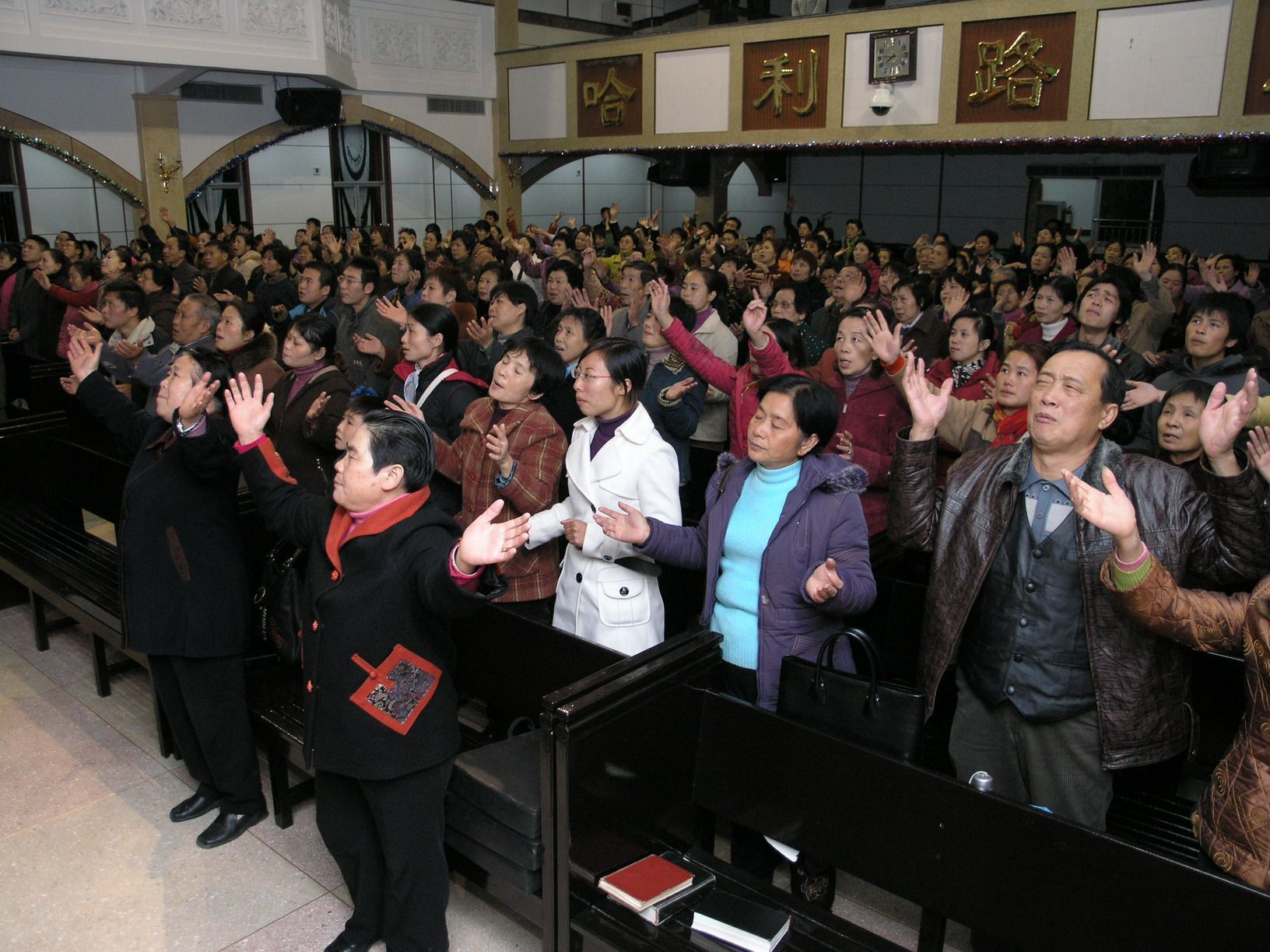1930s

A large group of Christians attending Bible school at Wenling in 1931.
A Mighty Revival
Although it was still more than 20 years before the Communists took full control of China and declared the People's Republic, Zhejiang was overrun by Communist forces in 1927, which severely tested Christians throughout the province. By God's providence, Zhejiang had experienced powerful revival in the late 1920s, and this carried over into the 1930s, preparing the Church for the dark era that was to follow.
The 1930s was a time of great difficulty for the people of Zhejiang, with hordes of bandits roaming the countryside pillaging and murdering their hapless victims. In the midst of the commotion, however, the wind of God's Spirit blew on the people of Zhejiang, and the hardships caused thousands of disillusioned people to seek shelter in Jesus Christ. Decades later, a church historian wrote: "During the 1930s a mighty revival swept through this region, leaving a large, dynamic church by the time of the Communist takeover in 1949."[1]
One catalyst for the revival in Zhejiang was the emergence of 'evangelistic bands'. Chinese preaching teams had been formed by evangelists in other parts of the country, and the concept spread to Zhejiang in the early 1930s.
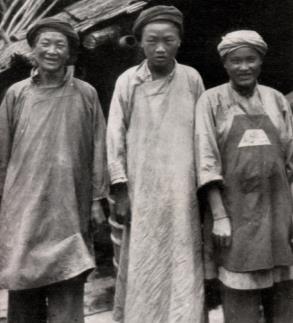
The ex-bandit preaching the gospel on the streets of Taizhou.
As the revival spread throughout the towns and villages, the transformative power of Christ touched people from every walk of life. Rich and poor, young and old, were swept into the kingdom of God. At Taizhou, one man described as a "part-time fisherman, part-time bandit" listened intently to a preacher and his heart was deeply touched. The next morning he heard that a team of evangelists was going into the surrounding villages, so he tagged along to learn more about this new faith. The more he heard of the message, the more convicted he became of his sins, until
"He was thoroughly miserable, and yet unable to leave the men.... He believed that Christ was the Savior and the joy of the Lord filled his soul. Day after day he went about with that evangelistic band with a heart bubbling over with joy, and before long he too was able to tell of this wonderful new Savior he had found.
Naturally, a man like that was well known and his story was listened to by many who had been his former companions in sin. But no more was he to walk with them. His old life was over, and during the times when he was at home between his fishing trips, he went out all over the countryside with a bag of tracts on his shoulder and some gospel posters, seeking to catch men."[2]
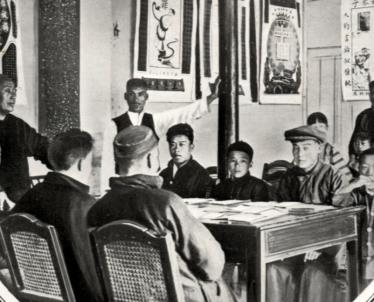
A street chapel at Wenzhou in the 1930s, where enquirers were taught the gospel.
Yongkang becomes a hub of Blessing
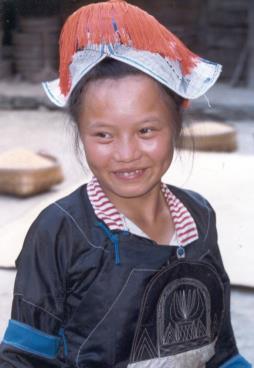
In 1937 Mrs. Lu was the oldest Christian in Yongkang, having been baptized 44 years earlier.
The revival reached the central Zhejiang town of Yongkang in 1936. Although in most ways it was a nondescript town, the people of Yongkang had long been interested in the gospel. The first baptisms took place there in 1886, causing a missionary to write: "The people of Yongkang, the scholars, and even the boys, are most respectful and some are interested. A congregation of 40 to 60 regularly attend every Lord's Day."[3]
Later, a missionary couple, the Gracies, were assigned to Yongkang. In their 1906 annual report they stated: "1,542 services or meetings were held, 992 of these being in the city. The membership increased to 104, representing 42 towns and villages, while attendances in the city services increased to an average of 160."[4]
The Church in Yongkang continued to grow until the mid-1920s, when it fell into a slump due to the political upheaval and spirit of lawlessness gripping the country, and the number of Christians in Yongkang fell to half of their previous number. The revival of the 1930s therefore came at just the right time, and the Holy Spirit arrested the decline and again caused the light to shine throughout the blessed district. By the end of 1936 Yongkang boasted 518 believers in 16 congregations.
A Medium turns to Jesus
A startling conversion occurred at Yongkang when an old white-haired woman surrendered to Jesus Christ. She was widely known as a powerful medium who had often gone into demonic trances to communicate with the spirit world. One day she heard the gospel while listening to a Spirit-filled preacher, and a short time later a voice told her:
"'If you have anything to do with this Jesus I cannot use you. I have no use for you. He is true. Go to Him' .... She turned from Satan to God and was gloriously saved by His grace. The woman met with much opposition from her husband and relatives, but the Lord protected her....
All traces of idol and demon worship were swept clean from her home and found a place in the flames. The woman, her sons and her daughter-in-law were all baptized and now services are held every Sunday in her home where before it was a 'synagogue of Satan'."[5]
The medium's conversion was just one reason the revival blazed so strongly in Yongkang. In 1936 missionary G. W. Bailey visited the district and reported,
"The Church there still seems to be in the midst of a genuine revival, and we cannot but stand awed and praiseful as we witness what God by His Spirit is doing in their midst....
We were overwhelmed when the leaders told us that there would probably be over 100 people ready for baptism at this time, and there were 126 men and women baptized during those days. The examination of candidates took two days, and the men and women crowded the door waiting for their names to be called. What a motley crowd—youths and maidens, old men and women, blind, deaf, lame, all seeking baptism. Some were so old and feeble that we could not but feel they were only just in time."[6]
Yongkang has continued to be a beacon of spiritual light in central Zhejiang, and as recently as 2002 the Three-Self Patriotic churches alone reported 21,300 members in the city, meeting in 71 congregations.[7] Today, including unregistered house church believers, Yongkang contains approximately 80,000 Evangelical Christians,[8] and the city continues to shine as an example of God's forgiveness and love for the lost.
The Horrors of 1938
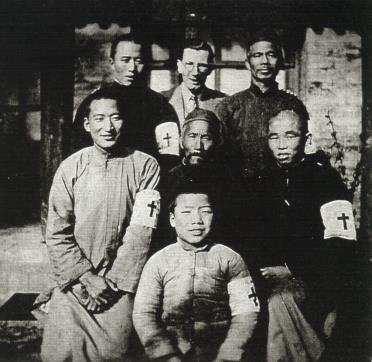
Christian relief workers helping terrorized war refugees.
After years of war and lawlessness had decimated Zhejiang, 1938 proved to be the height of misery as the Japanese army marched through the province, looting, raping and killing as they went. Previously admired as one of the most beautiful cities in the world, Hangzhou was reportedly reduced to being
"broken down and perplexed. The inhabitants have been smitten and made desolate, and their means of livelihood destroyed.... Day after day, mechanized battalions poured into the city, and the heavy tread of infantry, and the clang of steel, made war a stark reality.
With the advent of this military machine, the residue of the populace was engulfed in terrible suffering and grinding oppression. It was pitiable to behold men, women and children cowed into a state of impotent terror. From the very first day this charming lakeside metropolis became a rendezvous of death and destruction. Hounded by fear and tortured with anxiety, trembling women and children ran hither and thither to hide from the assaulting hand."[9]
In the midst of this diabolical trail of destruction, all remaining foreign missionaries and many Chinese Christians poured out their lives to help the terrified population. Certain areas of Hangzhou, including the Red Cross headquarters and various mission compounds, were declared 'safe zones'. Within hours an estimated 25,000 women and children scurried to those places, hoping to gain refuge from the terrible Japanese, who had burnt down or demolished most of the homes in the city.
The American Baptist Mission was one of the Christian entities to open its land and buildings to the desperate. One missionary remarked: "What a wonderful opportunity this presented to deal bread to the hungry; to relieve the fatherless and bring in the poor that have been cast out; to clothe the naked and plead for the widow; to visit the sick and bring healing balm to the wounded! .... The other day, I came across a group whose faces were transfigured with radiant delight, for they had been born again, and bore the mark of belonging to the household of God."[10]
In the midst of the Japanese invasion, God preserved His children and many testimonies emerged of the supernatural protection of the Holy Spirit. When the air-raid sirens sounded, one young Christian man hurried into a bomb shelter, where he waited with 13 other people in a cramped space. When the Japanese planes had passed overhead,
"thinking the coast was clear he came out and encountered a Japanese soldier, who at once made ready to shoot him. He cried, 'Wait a minute while I pray.' Kneeling down, he prayed to the Lord to receive his spirit. When he opened his eyes, the officer asked if there were any more like him there, with the result that the whole lot were told to get away as quickly as possible.
Another woman was praying in a Gospel Hall, which had only two days before housed over 100 refugees. She was the only one left and was kneeling on the floor praying, when the place was badly bombed; the cross-beam of the roof fell in the shape of an inverted "V" above her head. Had she been standing she would certainly have been killed."[11]
The total number of Evangelical Christians in Zhejiang had been 27,902 according to a 1922 survey, and although no systematic research was able to be conducted during the 1930s, it is likely the number of believers in the province had increased to more than 100,000 by the end of 1939.
During the 1930s the most significant new church movement to emerge in Zhejiang was the Little Flock, which had been founded by Watchman Nee (Chinese name: Ni Tuosheng) in the 1920s. From the group's base in Shanghai, Nee trained leaders to spread the movement, and during the 1930s "the major expansion took place in the coastal provinces of Fujian and Zhejiang.... By 1940, in Zhejiang alone, they had 262 assemblies with a total membership of 39,000."[12]
© This article is an extract from Paul Hattaway's book 'Zhejiang: The Jerusalem of China'. You can order this or any of The China Chronicles books and e-books from our online bookstore .
1. Jonathan Chao (ed.). The China Mission Handbook: A Portrait of China and its Church (Hong Kong: Chinese Church Research Center, 1989), p. 136.
2. B. R. England, "An Ex-Bandit Evangelist," China's Millions (July 1933), p. 129.
3. A. K. MacPherson, "The Evolution of the Church in Yungkang," China's Millions (July 1937), p. 125.
4. MacPherson, "The Evolution of the Church in Yungkang," pp. 125-6.
5. G. W. Bailey, "A Genuine Revival," China's Millions (February 1936), p. 25.
6. Bailey, "A Genuine Revival," pp. 24-5.
7. TSPM China Prayer Calendar, 2002.
8. See the 'Table of Christians in Zhejiang' in the Appendix of this book.
9. China Inland Mission, Through Fire: The Story of 1938 (London: China Inland Mission, 1939), pp. 22-3.
10. China Inland Mission, Through Fire, pp. 24-5.
11. G. I. F. Taylor, "Remarkable Answers to Prayer," China's Millions (October 1939), p. 159.
12. Lyall, God Reigns in China, p. 112.





